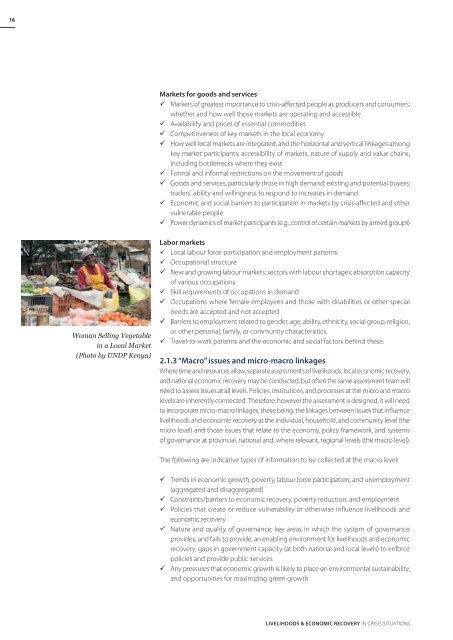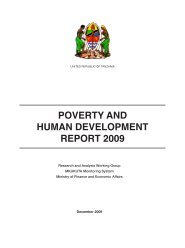Download PDF (4.08 MB) - ReliefWeb
Download PDF (4.08 MB) - ReliefWeb
Download PDF (4.08 MB) - ReliefWeb
Create successful ePaper yourself
Turn your PDF publications into a flip-book with our unique Google optimized e-Paper software.
16<br />
Markets for goods and services<br />
Markets of greatest importance to crisis-affected people as producers and consumers;<br />
whether and how well those markets are operating and accessible<br />
Availability and prices of essential commodities<br />
Competitiveness of key markets in the local economy<br />
How well local markets are integrated, and the horizontal and vertical linkages among<br />
key market participants; accessibility of markets, nature of supply and value chains,<br />
including bottlenecks where they exist<br />
Formal and informal restrictions on the movement of goods<br />
Goods and services, particularly those in high demand; existing and potential buyers;<br />
traders’ ability and willingness to respond to increases in demand<br />
Economic and social barriers to participation in markets by crisis-affected and other<br />
vulnerable people<br />
Power dynamics of market participants (e.g., control of certain markets by armed groups)<br />
Woman Selling Vegetable<br />
in a Local Market<br />
(Photo by UNDP Kenya)<br />
Labor markets<br />
Local labour force participation and employment patterns<br />
Occupational structure<br />
New and growing labour markets; sectors with labour shortages; absorption capacity<br />
of various occupations<br />
Skill requirements of occupations in demand<br />
Occupations where female employees and those with disabilities or other special<br />
needs are accepted and not accepted<br />
Barriers to employment related to gender, age, ability, ethnicity, social group, religion,<br />
or other personal, family, or community characteristics<br />
Travel-to-work patterns and the economic and social factors behind these.<br />
2.1.3 “Macro” issues and micro-macro linkages<br />
Where time and resources allow, separate assessments of livelihoods, local economic recovery,<br />
and national economic recovery may be conducted, but often the same assessment team will<br />
need to assess issues at all levels. Policies, institutions, and processes at the micro and macro<br />
levels are inherently connected. Therefore, however the assessment is designed, it will need<br />
to incorporate micro-macro linkages, these being. the linkages between issues that influence<br />
livelihoods and economic recovery at the individual, household, and community level (the<br />
micro level) and those issues that relate to the economy, policy framework, and systems<br />
of governance at provincial, national and, where relevant, regional levels (the macro level).<br />
The following are indicative types of information to be collected at the macro level:<br />
Trends in economic growth, poverty, labour force participation, and unemployment<br />
(aggregated and disaggregated)<br />
Constraints/barriers to economic recovery, poverty reduction, and employment<br />
Policies that create or reduce vulnerability or otherwise influence livelihoods and<br />
economic recovery<br />
Nature and quality of governance; key areas in which the system of governance<br />
provides, and fails to provide, an enabling environment for livelihoods and economic<br />
recovery; gaps in government capacity (at both national and local levels) to enforce<br />
policies and provide public services<br />
Any pressures that economic growth is likely to place on environmental sustainability,<br />
and opportunities for maximizing green growth<br />
Livelihoods & Economic Recovery in Crisis Situations





